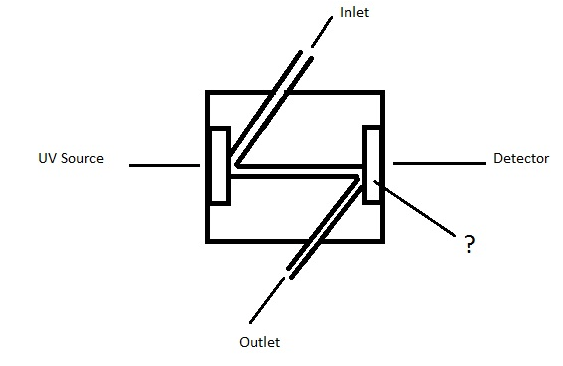This set of Analytical Instrumentation Problems focuses on “Detection System of Liquid Chromatography”.
1. Bulk property detectors used in liquid chromatography does not respond to which of the following properties?
a) Refractive index
b) Density
c) Properties of solutes
d) Dielectric constant
View Answer
Explanation: Bulk property detectors respond only to bulk properties of the mobile phase. It does not respond to properties of solutes.
2. Which of the following is not a property of a good detector used in liquid chromatography?
a) Good sensitivity
b) Ability to function in the presence of a large background signal
c) Short response time
d) Volume of detector must be large
View Answer
Explanation: The volume of the detector must be small. If the volume of the detector is large it may lead to band broadening.
3. Detector selectivity is more important in Liquid chromatography than in Gas chromatography.
a) True
b) False
View Answer
Explanation: Detector selectivity is more important in Liquid chromatography than in Gas chromatography. This is because of liquid chromatography, chances of overlapping are higher.
4. Which of the following UV absorbance detectors provide a real time spectrum of the component of interest?
a) Continuous wavelength detector
b) Variable wavelength detector
c) Scanning wavelength detector
d) Fixed wavelength detector
View Answer
Explanation: Scanning wavelength detector provides a real time spectrum of the component of interest. UV visible detector is the most widely used detection system.
5. Fluorescence detection is less selective than absorption detection.
a) True
b) False
View Answer
Explanation: Fluorescence detection is more selective than absorption detection. This is because of its high sensitivity.
6. Which of the following detectors depend on Snell’s law at the interface between the cell wall and the flowing liquid to deflect the light beam?
a) Electrochemical detectors
b) Fluorescence detectors
c) Refractive index detectors
d) Thermal conductivity detectors
View Answer
Explanation: Refractive index detectors depend on Snell’s law at the interface between the cell wall and the flowing liquid to deflect the light beam. Changes in refractive index are monitored by a position sensor.
7. Refractive index detectors used in liquid chromatography are not based on which of the following processes?
a) Interference
b) Refraction
c) Reflection
d) Absorption
View Answer
Explanation: Refractive index detectors used in liquid chromatography are not dependent on absorption. It depends on reflection, refraction and interference.
8. Which of the following detectors can be used for detection of amino acids in protein hydrolyzates by introducing the reagent dansylchloride in the sample?
a) Electrochemical detectors
b) Fluorescence detectors
c) Refractive index detectors
d) Thermal conductivity detectors
View Answer
Explanation: Fluorescence detectors can be used for detection of amino acids in protein hydrolyzates by introducing the reagent dansylchloride in the sample. Other compounds that can be detected are petroleum products and natural products.
9. The reference cell is packed with which of the following in the Adsorption detector used in liquid chromatography?
a) Inactive glass beads
b) Porous glass beads
c) Alumina
d) Silica
View Answer
Explanation: In Adsorption detector used in liquid chromatography, the reference cell is packed with inactive glass beads. The other detector cavity is packed with silica, alumina or porous glass beads.
10. Which of the following is true about Laser detectors used in liquid chromatography?
a) Causes thermal distortion has decreased sensitivity
b) Causes thermal distortion has increased sensitivity
c) Does not cause thermal distortion, has decreased sensitivity
d) Does not cause thermal distortion, has increased sensitivity
View Answer
Explanation: Laser detectors used in liquid chromatography cause thermal distortion and have decreased sensitivity. This is because of the high energies of a laser.
11. Which of the following detectors used in liquid chromatography is also called micro-adsorption detector?
a) Electrochemical detectors
b) Fluorescence detectors
c) Refractive index detectors
d) Thermal detectors
View Answer
Explanation: Another name for the thermal detector is micro-adsorption detector. The operation depends upon temperature changes taking place due to the heat of adsorption.
12. In UV-Visible detectors, the cells are not made of which of the following materials?
a) Quartz
b) Teflon
c) Silica
d) KELF
View Answer
Explanation: The cells in UV-Visible detectors are made of quartz, KELF and Teflon. They are not made of silica.
13. Which of the following is not a feature of refractive index type detectors?
a) Higher potential sensitivity
b) Low cost
c) High volume flow rates
d) Easy cell accessibility
View Answer
Explanation: Refractive index type detectors have low volume flow rates. It is one of the major advantages of the refractive index type of detectors.
14. Which of the following detectors can detect almost any component?
a) Combining two UV detectors
b) Combining RI and UV detectors
c) Mass detector
d) Laser-based detectors
View Answer
Explanation: Combining RI and UV detectors almost any component can be detected. In some cases, single detection system may give incorrect results.
15. Given below is the diagram of Ultraviolet detector used in liquid chromatography. Identify the unmarked component.

a) Collimator
b) Lens
c) Monochromator
d) Quartz window
View Answer
Explanation: The part that is not marked is quartz window. This detector is used to detect components that absorb any wavelength in the UV-Visible region.
Sanfoundry Global Education & Learning Series – Analytical Instrumentation.
To practice all areas of Analytical Instrumentation Problems, here is complete set of 1000+ Multiple Choice Questions and Answers.
If you find a mistake in question / option / answer, kindly take a screenshot and email to [email protected]
- Check Instrumentation Engineering Books
- Apply for Instrumentation Engineering Internship
- Check Analytical Instrumentation Books
- Practice Instrumentation Engineering MCQs
